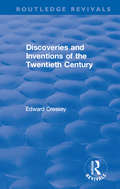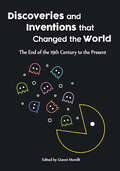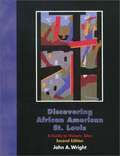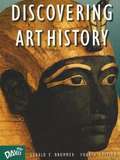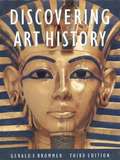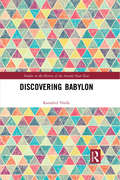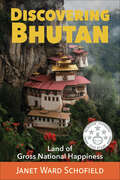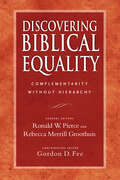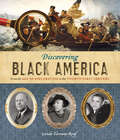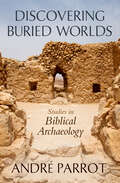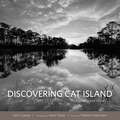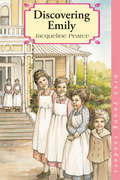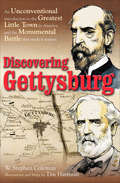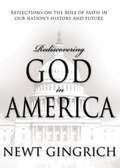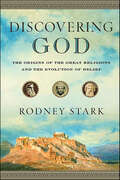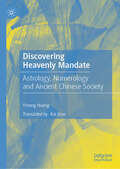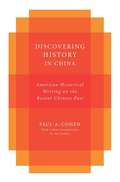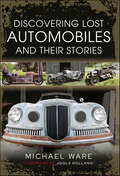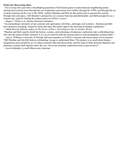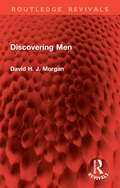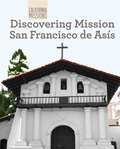- Table View
- List View
Discoveries and Inventions of the Twentieth Century (Routledge Revivals)
by Edward CresseyThe book is written for those, young and old, who wish to have a non-technical account of the great scientific and material triumphs which man has achieved and is achieving in their own day; and it seemed desirable to give first place to those theories, facts, and accomplishments which are now exercising the greatest influence upon human life. For science exists not so much to tickle the intelligences of the few as to brighten the lot of the many.
Discoveries and Inventions that Changed the World: The End of the 19th Century to the Present
by Gianni MorelliSome of the Greatest Inventions of All TimeLearn about some of the greatest inventions of all time and how they changed our world forever in this fascinating book of inventions and daring discoveries.World changing history. Who created plastic? How was the zipper invented? Who created the aspirin that takes away our headaches? All of these questions (and more) are answered by author Gianni Morelli who expertly delves into the fascinating facts behind some of the most important historical inventions since the end of the 19th century.Historical inventions and life-changing discoveries. From ground-breaking technology to life-changing advances in medicine, travel through time in this impressive book of discoveries and inventions. You’ll look at our world in a completely different light after learning how we got to where we are today.Inside, you’ll find:A way to connect our present to our past, giving hope for the possibilities of tomorrowMeaningful knowledge of world changing historyA deeper understanding of the world around usIf you liked books such as Power and Progress, Invention and Innovation, or ColdFusion Presents: New Thinking, you’ll love Discoveries and Inventions that Changed the World.
Discovering African American St. Louis: A Guide to Historic Sites (Second Edition)
by John WrightAfrican Americans have been part of the story of St. Louis since the city's founding in 1764. Unfortunately, most histories of the city have overlooked or ignored their vital role, allowing their influence and accomplishments to go unrecorded or uncollected; that is, until the publication of Discovering African American St. Louis: A Guide to Historic Sites in 1994. A new and updated 2002 edition is now available to take readers on a fascinating tour of nearly four hundred African American landmarks. From the boyhood home of jazz great Miles Davis in East St. Louis, Illinois, to the site of the house that sparked the landmark Shelley v. Kraemer court case, the maps, photographs, and text of Discovering African American St. Louis record a history that has been neglected for too long. The guidebook covers fourteen regions east and west of the Mississippi that represent St. Louis's rich African American heritage. In the words of historian Gary Kremer, "No one who reads this book and visits and contemplates the places and peoples whose stories it recounts will be able to look at St. Louis in the same way ever again. "
Discovering Art History
by Gerald F. BrommerThis new edition of Discovering Art History is an in-depth, comprehensive approach to art. The program includes an extensive survey of Western art, studies of non-Western art, as well as an introduction to art appreciation. Engaging studio activities throughout the text are keyed to chapter content. This premier art history program will show students how the visual arts serve to shape and reflect ideas, issues, and themes from the time of the first cave paintings to the twenty-first century. The Student Book includes:In-depth profiles of artists, artistic periods, and movements Vibrant maps, timelines, and diagrams Student profiles for peer comparison of studio exercises
Discovering Art History (Third Edition)
by Gerald F. BrommerThis student textbook presents the history of art through the ages. It offers a dynamic format and a flexible structure, with maps, timelines and quotations to add historical perspective to art periods. A teacher's resource binder and disk are available separately.
Discovering Art History (Third Edition)
by Gerald F. BrommerThis student textbook presents the history of art through the ages. It offers a dynamic format and a flexible structure, with maps, timelines and quotations to add historical perspective to art periods. A teacher's resource binder and disk are available separately.
Discovering Babylon (Studies in the History of the Ancient Near East)
by Rannfrid ThelleThis volume presents Babylon as it has been passed down through Western culture: through the Bible, classical texts, in Medieval travel accounts, and through depictions of the Tower motif in art. It then details the discovery of the material culture remains of Babylon from the middle of the 19th century and through the great excavation of 1899-1917, and focuses on the encounter between the Babylon of tradition and the Babylon unearthed by the archaeologists. This book is unique in its multi-disciplinary approach, combining expertise in biblical studies and Assyriology with perspectives on history, art history, intellectual history, reception studies and contemporary issues.
Discovering Bhutan: Land of Gross National Happiness
by Janet Ward Schofield“People from foreign countries shall not be welcomed” is carved into a black stone containing Bhutan's founding document, which may help to explain why this reclusive Himalayan kingdom, sometimes called the Last Shangri-La, is so little understood.Janet Schofield felt like she jumped off a cliff when, in her mid-sixties, she left her position as a professor of psychology in the US to help start a new college in the remote Himalayan kingdom, where gods live on mountain tops, mermaids live in lakes, and spirits inhabit rocks, cliffs and trees. She went on a one-year contract, but stayed for more than a decade, enchanted by the beauty of Bhutan's pristine environment, the richness of its unique and fascinating culture and the warm welcome she received from people in all walks of life- yak herders, monks, students and members of the royal family alike.Here she offers you an enthralling portrait of this tiny, reclusive country has which gained international admiration for its remarkable environmental policies, a peaceful transition from absolute monarchy to democracy, success in dealing with the Covid-19 pandemic and for originating the ground-breaking development philosophy of Gross National Happiness.Hike with Janet three days to the home of the abominable snowman, sleeping on the dusty wooden floor of a school and in a dilapidated shed. Join her at the King's palace for brunch, served outdoors on elegant white and gold china. Accompany her as she teaches young monks English vocabulary using Simon Says. Learn how animist and Buddhist practices shape everything from children's names to environmental preservation. Reflect with her on what is lost and what it gained as a country that changed little over 500 years, traditionally choosing respect for elders, the environment and local deities as well as cohesion within villages and isolation from the outside world, enters the age of the internet and experiences the challenges that this poses while also striving for Gross National Happiness..
Discovering Biblical Equality: Complementarity Without Hierarchy
by Ronald W. Pierce Rebecca Merrill GroothuisDiscussions surrounding the roles of men and women--whether in the church, the home or society at large--never seem to end, often generating more heat than light. Such debate is still important, though, because this issue directly affects every member of Christ's body. What we believe the Bible teaches on these matters shapes nearly all we do in the church. In addition, these questions deserve further thought and reflection because neither side has won the day. In an effort to further discussion, Ronald W. Pierce and Rebecca Merrill Groothuis (general editors), with the aid of Gordon D. Fee (contributing editor), have assembled a distinguished array of twenty-six evangelical scholars firmly committed to the authority of Scripture to explore the whole range of issues--historical, biblical, theological, hermeneutical and practical. While dispelling many of the myths surrounding biblical equality, they offer a sound, reasoned case that affirms the complementarity of the sexes without requiring a hierarchy of roles. Contributors include Ruth A. Tucker, Janette Hassey, Richard S. Hess, Linda L. Belleville, Aída Besançon Spencer, Craig S. Keener, I. Howard Marshall, Peter H. Davids, Walter L. Liefeld, Stanley J. Grenz, Kevin Giles, Roger Nicole, William J. Webb, Sulia Mason, Karen Mason, Joan Burgess Winfrey, Judith K. Balswick, Jack O. Balswick, Cynthia Neal Kimball, Mimi Haddad, Alvera Micklesen, R. K. McGregor Wright and Alice P. Mathews. Here is a fresh, positive defense of biblical equality that is at once scholarly and practical, irenic and yet spirited, up-to-date and cognizant of opposing positions.
Discovering Black America: From the Age of Exploration to the Twenty-First Century
by Linda Tarrant-ReidFrom the first African explorers to the first black president, this illustrated history is an excellent resource and “an epic work” (School Library Journal).Discovering Black America is an unprecedented account of more than 400 years of African American history set against a background of American and global events. It begins with a black sailor aboard the Niña with Christopher Columbus and continues through the colonial period, slavery, the Civil War, Jim Crow, and civil rights to the first African American president in the White House. With first-person narratives from diaries and journals, interviews, and archival images, Discovering Black America provides an intimate understanding of this extensive history. “Engaging . . . brings to light many intriguing and tragically underreported stories.” —Kirkus Reviews (starred review)“Reproductions of historical documents, photographs, and artwork provide a sense of immediacy to this immersive tapestry, which reaches well beyond the milestones typically outlined in history books.” —Publishers Weekly (starred review)“Absolutely gorgeous in design, with a harmonious marriage of text and colorful archival images, this is the kind of book that invites browsing, and its extensive reach will make this a go-to title for report writers.” —School Library Journal“Begins with the first African explorers and seamen arriving in the New World in the fifteenth century, and . . . ends with the presidential election of Barack Obama . . . meticulous footnotes and a bibliography of recommended books…An excellent title for classroom support.” —Booklist“Thoroughly researched and documented…an outstanding resource for students. The primary source documents, photographs, and archival maps that complement this compelling account will engage readers.” —Library Media Connection (highly recommended)An NCSS/CBC Notable Social Studies Trade Book for Young People
Discovering Buried Worlds
by André ParrotIn this classic work, the eminent archeologist recounts his historic excavations and the significant Biblical findings they revealed. French archeologist André Parrot led some of the most important digs of the twentieth century. In 1933, he began excavations on the right bank of the Euphrates River in present-day Syria. Uncovering numerous artifacts and architecture, he was able to identify the site as the Mesopotamian city of Mari. In this wide-ranging work, Parrot vividly chronicles his experiences, and shows how ancient discoveries can connect the biblical world to ours. In accessible and engaging prose, Parrot also discusses the history of archeological excavation and many of the civilizations we have learned about through the practice. He also delves into the ways archeological discovery has helped shed light on the Bible itself.
Discovering Cat Island: Photographs and History
by John CuevasCat Island, just off the Mississippi Gulf Coast shoreline, has been home to some of the most dramatic events and remarkable stories in the nation's history. While some of these stories are fact, others are colorful fables passed down through the ages with such conviction they have become true in the hearts and minds of many. Between fact and fiction is the undeniable reality: Cat Island is one of the most historically significant landmarks on the Mississippi Gulf Coast.Featuring over 160 black-and-white photographs by Jason Taylor and a foreword by Mississippi's Secretary of State Delbert Hosemann, John Cuevas's Discovering Cat Island guides readers through Cat Island with stories and histories of twenty-nine sites--both real and imagined--of the legendary barrier island. Originally owned by the Cuevas family as part of a Spanish land grant to Juan de Cuevas in 1781, Cat Island boasts a colorful history that includes events related to the notorious pirate Jean Lafitte and the outlaw James Copeland, both of whom were thought to have buried their stolen treasure somewhere on the island; the Battle of New Orleans; and the War of 1812. The island served as one of the staging areas for the Seminole forced to abandon their homes and take part in the Trail of Tears. In the twentieth century, the island was a convenient transfer point for gangsters and local bootleggers shipping booze during Prohibition before becoming a US military training camp site during World War II. In 1988, Cat Island became the location of the first oil drilling ever in the Mississippi Sound and in 2010 was one of the islands devastated by the BP Deepwater Horizon oil spill.
Discovering Emily (Orca Young Readers #Sequel To Discovering Emily)
by Jacqueline PearceYoung Emily Carr has no interest in learning to be a lady. She loves animals and the outdoors, and she is beginning to discover that what she loves most of all is drawing and painting. Will she find a way to develop her talent in the straitlaced world of nineteenth-century Victoria, British Columbia? Discovering Emily is the first of two books in a series. Book two is Emily's Dream
Discovering Gettysburg: An Unconventional Introduction to the Greatest Little Town in America and the Monumental Battle that Made It Famous
by W. Stephen Coleman Tim HartmanGettysburg.Does any other single word in any language invoke so much passion and angst, enthusiasm and sadness, as do those ten letters? But what IS Gettysburg, exactly? I am almost embarrassed to say I discovered the answer to that questionor at least approached an answeronly late in life.Of course, Gettysburg is a small charming city nestled in south-central Pennsylvania, but in so many ways it beggars description. For about half the year its streets are mainly empty, its businesses quiet, the weather cold and blustery. For the other months, however, the place literally teems with hundreds of thousands of visitors, bustling streets and shops, and more than a handful of unique larger-than-life characters whose fan base spans the globe.And then there is the battlethe eventof the Civil War. The battle that raged there during the first days of July 1863 at the price of more than 50,000 casualties decided much (just how much depending upon who you believe) and forever stamped that place with its passion and angst and enthusiasm and its lingering, forever sadness. Its monuments and guns and plaques tell the story of the colossal clash of arms and societies, just as its National Cemetery bears silent witness to at least part of the cost of that bloody event.And somehow this greatest little town in America, this mammoth battle, its influential characters (living and dead), its deep meaning and profound influence on our society largely escaped me for nearly six decades. That ended a couple years ago when I finally paid a visit. My journey from the uninitiated to the fully converted only took a short time, but I felt compelled to pen my experiences as they unfolded. And so you hold in your hands Discovering Gettysburg: An Unconventional Introduction to the Greatest Little Town in America and the Monumental Battle that Made It Famous.In it, you will visit with me a host of famous and off-the-beaten-path places on the battlefield, explore the historic town of Gettysburg as it is today, chat with some of the towns fascinating resources, and follow along, as I did, with some of the most engaging storytelling I have ever had the pleasure of hearing. And nowhere inside will you be bothered with footnotes or stumble your way through academic mumbo jumbo. Thankfully, my friend and award-winning cartoonist Tim Hartman agreed to provide the magnificent maps and outstanding caricatures that grace this book.Discovering Gettysburg is, I fully admit, rather unconventional. But so is the place, the event, and the experience of that hallowed ground.
Discovering God in Our Nation's Capital: Reflections on the Role of Faith in Our Nation's History and Future
by Newt GingrichSignificant monuments, memorials, and artifacts found in our Nation's capital are Creator-endowed as seen through a walk-through tour of Washington D.C.
Discovering God: The Origins of the Great Religions and the Evolution of Belief
by Rodney StarkWinner of the 2008 Christianity Today Award of Merit in Theology/EthicsThe History of God In Discovering God, award-winning sociologist Rodney Stark presents a monumental history of the origins of the great religions from the Stone Age to the Modern Age and wrestles with the central questions of religion and belief.
Discovering Great Artists: Hands-On Art Experiences in the Styles of Great Masters (Bright Ideas for Learning #Vol. 6)
by Kim Solga MaryAnn F. KohlDiscovering Great Artists is a creative collection of easy art-appreciation activities for children. Kids will find 110 amazingly fun and unique projects to experience the styles and techniques of the great masters from the Renaissance to the present. A brief biography of each artist is included with each fully illustrated, child-tested art activity that introduces the featured painting. Artists include painters, sculptors, photographers and more.
Discovering Heavenly Mandate: Astrology, Numerology and Ancient Chinese Society
by Yinong HuangThis book adopts a multidisciplinary approach, incorporating knowledge and techniques from disciplines such as astronomy and history. The purpose of astrological divination is to discern the will of the heavens, and its subjects are the ruling class or the entire social body of a nation. The selection of auspicious methods is aimed at seeking good fortune and avoiding misfortune, with its influence ranging from the imperial family to the common people. By comparing them with ancient Chinese textual records, it seeks to verify their authenticity. Based on this foundation, the book explores the origins of certain important astronomical events and divinatory behavioral patterns in ancient times, as well as the reasoning behind the actions of ancient Chinese people. Overall, this book provides significant inspiration and reference for scholars and researchers in the field of history of social astronomy in China and history of Sino-Western exchanges, in terms of ideas and research methodologies.
Discovering History in China: American Historical Writing on the Recent Chinese Past
by Paul A. CohenSince its first publication, Paul A. Cohen's Discovering History in China has occupied a singular place in American China scholarship. Translated into three East Asian languages, the volume has become essential to the study of China from the early nineteenth century to today. Cohen critiques the work of leading postwar scholars and is especially adamant about not reading China through the lens of Western history. To this end, he uncovers the strong ethnocentric bias pervading the three major conceptual frameworks of American scholarship of the 1950s and 1960s: the impact-response, modernization, and imperialism approaches. In place of these, Cohen favors a "China-centered" approach in which historians understand Chinese history on its own terms, paying close attention to Chinese historical trajectories and Chinese perceptions of their problems, rather than a set of expectations derived from Western history. In an important new introduction, Cohen reflects on his fifty-year career as a historian of China and discusses major recent trends in the field. Although some of these developments challenge a narrowly conceived China-centered approach, insofar as they enable more balanced comparisons between China and the West and recast the Chinese and their history in more human, less exotic terms, they powerfully affirm the central thrust of Cohen's work.
Discovering History in China: American Historical Writing on the Recent Chinese Past (Studies of the Weatherhead East Asian Institute, Columbia University)
by Paul CohenSince its first publication, Paul A. Cohen's Discovering History in China has occupied a singular place in American China scholarship. Translated into three East Asian languages, the volume has become essential to the study of China from the early nineteenth century to today. Cohen critiques the work of leading postwar scholars and is especially adamant about not reading China through the lens of Western history. To this end, he uncovers the strong ethnocentric bias pervading the three major conceptual frameworks of American scholarship of the 1950s and 1960s: the impact-response, modernization, and imperialism approaches. In place of these, Cohen favors a "China-centered" approach in which historians understand Chinese history on its own terms, paying close attention to Chinese historical trajectories and Chinese perceptions of their problems, rather than a set of expectations derived from Western history. In an important new introduction, Cohen reflects on his fifty-year career as a historian of China and discusses major recent trends in the field. Although some of these developments challenge a narrowly conceived China-centered approach, insofar as they enable more balanced comparisons between China and the West and recast the Chinese and their history in more human, less exotic terms, they powerfully affirm the central thrust of Cohen's work.
Discovering Lost Automobiles and their Stories
by Michael WareMany enthusiasts dream of finding a Bugatti or a Bentley in a barn or a long disused building. In reality, such finds are more likely to be an Austin 7, Ford Popular or a Mini. This book is stuffed with these so called “barn finds”. The author has tried to find out the background to the abandonment and the previous history of the “as found” car when it was in regular use. Why was it put away and apparently forgotten? Many of the stories have appeared in his “Lost and Found” column in “Classic and Sports Car” magazine, but a book gives a chance for the expanded story to be told. The cars featured date from 1900 through till the 1980’s, most come from Great Britain and Europe but there are plenty from Australasia and USA. There are well over 200 different cars plus collections featured. Each story has at least one illustration to go with it. Some of the locations are bizarre, a Daimler buried under a rockery, a Porsche sunk in Lake Lucerne, a Rolls -Royce on the roof of a high rise building in Karachi, or a Morris 8 special in a Gloucestershire pond. There is a chapter on collections of cars, put together by seemingly eccentric owners who never got around to restoring them before their death. The author is not critical of any of these owners and is grateful for the number of cars they have saved from almost certain destruction.
Discovering Mars: A History of Observation and Exploration of the Red Planet
by William Sheehan Jim BellFor millenia humans have considered Mars the most fascinating planet in our solar system. We’ve watched this Earth-like world first with the naked eye, then using telescopes, and, most recently, through robotic orbiters and landers and rovers on the surface. <p><p>Historian William Sheehan and astronomer and planetary scientist Jim Bell combine their talents to tell a unique story of what we’ve learned by studying Mars through evolving technologies. What the eye sees as a mysterious red dot wandering through the sky becomes a blurry mirage of apparent seas, continents, and canals as viewed through Earth-based telescopes. Beginning with the Mariner and Viking missions of the 1960s and 1970s, space-based instruments and monitoring systems have flooded scientists with data on Mars’s meteorology and geology, and have even sought evidence of possible existence of life-forms on or beneath the surface. This knowledge has transformed our perception of the Red Planet and has provided clues for better understanding our own blue world. <p><p>Discovering Mars vividly conveys the way our understanding of this other planet has grown from earliest times to the present. The story is epic in scope—an Iliad or Odyssey for our time, at least so far largely without the folly, greed, lust, and tragedy of those ancient stories. Instead, the narrative of our quest for the Red Planet has showcased some of our species’ most hopeful attributes: curiosity, cooperation, exploration, and the restless drive to understand our place in the larger universe. Sheehan and Bell have written an ambitious first draft of that narrative even as the latest chapters continue to be added both by researchers on Earth and our robotic emissaries on and around Mars, including the latest: the Perseverance rover and its Ingenuity helicopter drone, which set down in Mars’s Jezero Crater in February 2021.
Discovering Men (Routledge Revivals)
by David H. MorganFeminism has put the critical study of men and masculinities firmly on to the academic agenda. First published in 1992, Discovering Men explores key issues in this field of study, looking at the theoretical, practical, and political difficulties that arise when men begin to study themselves, and considering the deep assumptions that underlie this area of enquiry.The author investigates the various strategies that may be adopted in exploring men and masculinities, drawing constantly on feminist critique of men’s theoretical and everyday practice. He recommends a critical re-reading of classic sociological texts to bring out the ‘hidden’ stories about masculinities that they tell, and re-examines well-documented areas within sociology, focusing on studies of men at work. He analyses situations where masculinity may be problematic, such as male unemployment, shifts in the gender balance in the workplace, and, historically, the suffrage movement.Discovering Men is one of the first books to focus on issues of methodology and epistemology and to explore the difficulties of men studying men in a patriarchal society. It will be beneficial for students and researchers of sociology, gender studies, women studies, social history, and research methodology.
Discovering Mission San Francisco De Asís (California Missions Ser.)
by Oscar CantilloLearn about the rich history of Mission San Francisco de Asís: how it started, the people who ran it, the indigenous population, and its legacy today.
